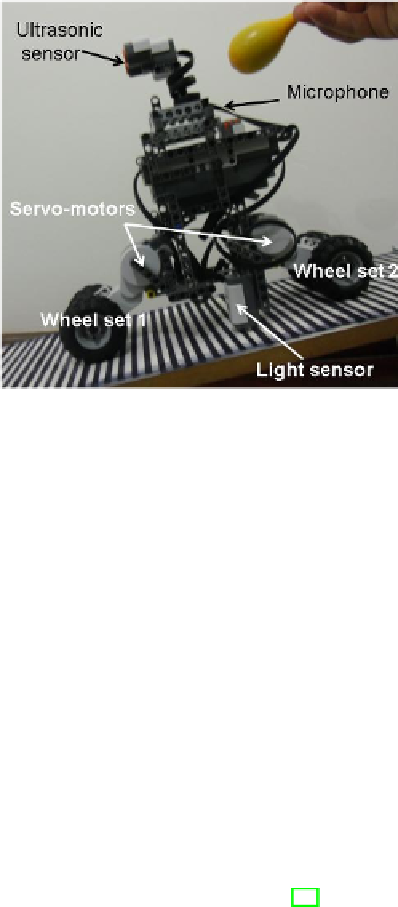Information Technology Reference
In-Depth Information
Fig. 1.
The Robot
a little aided by gravity; this fact produces a greater downward acceleration
(perceived by the acceleration detector). When the robot descends, the greater
downward acceleration also makes the black stripes alternate quicker in front of
the light detector than when the robot ascends. Another kind of stimulus that
appears when the robot moves downwards is the sound of the baby-shaker. This
sound stimulation tries to mimic the encouraging words of parents when the
baby performs downward movements over the ramp. This part of the system,
from environment to neurons, corresponds to the feedback part of the robot's
cybernetic loop.
The robot finally discovers how to purposely reproduce those motions that
push him downwards and how to synchronize them with each other into a pat-
tern. This happens, as will be shown, because a successful downward movement
of the robot is immediately followed by an intense rewarding stimulation from
sensory inputs to the neurons that contributed to the movement, allowing en-
hanced plasticity processes between these neurons.”
A similar kind of process has been detected in real organisms. In the case of
the vestibular system, Takeda and collaborators[10] discovered that vestibular
stimulation enhances acetylcholine production in the rat hippocampus (a brain
structure involved in short-term memory). Related to this, Manabe and collabo-
rators research[7], shows that acetylcholine is a neuro-modulator that contributes
to synaptic weights modulation or, in other words, to plasticity processes between
neurons.
At the light of the above processes, it would not be very audacious to hy-
pothesize that when a child is experiencing body acceleration (i.e. vestibular
stimulation) due to inclined floor therapy, plasticity processes in his hippocam-
pus could help him to consolidate short term memories related to the motor
tasks he is performing (as for example learning how to crawl).

Search WWH ::

Custom Search